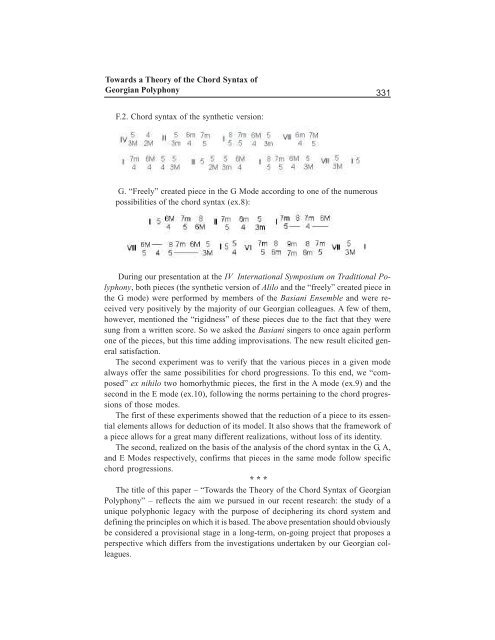Simha Arom & Polo Vallejo - International Research Center For ...
Simha Arom & Polo Vallejo - International Research Center For ...
Simha Arom & Polo Vallejo - International Research Center For ...
Create successful ePaper yourself
Turn your PDF publications into a flip-book with our unique Google optimized e-Paper software.
Towards a Theory of the Chord Syntax ofGeorgian Polyphony331F.2. Chord syntax of the synthetic version:G. “Freely” created piece in the G Mode according to one of the numerouspossibilities of the chord syntax (ex.8):During our presentation at the IV <strong>International</strong> Symposium on Traditional Polyphony,both pieces (the synthetic version of Alilo and the “freely” created piece inthe G mode) were performed by members of the Basiani Ensemble and were receivedvery positively by the majority of our Georgian colleagues. A few of them,however, mentioned the “rigidness” of these pieces due to the fact that they weresung from a written score. So we asked the Basiani singers to once again performone of the pieces, but this time adding improvisations. The new result elicited generalsatisfaction.The second experiment was to verify that the various pieces in a given modealways offer the same possibilities for chord progressions. To this end, we “composed”ex nihilo two homorhythmic pieces, the first in the A mode (ex.9) and thesecond in the E mode (ex.10), following the norms pertaining to the chord progressionsof those modes.The first of these experiments showed that the reduction of a piece to its essentialelements allows for deduction of its model. It also shows that the framework ofa piece allows for a great many different realizations, without loss of its identity.The second, realized on the basis of the analysis of the chord syntax in the G, A,and E Modes respectively, confirms that pieces in the same mode follow specificchord progressions.* * *The title of this paper – “Towards the Theory of the Chord Syntax of GeorgianPolyphony” – reflects the aim we pursued in our recent research: the study of aunique polyphonic legacy with the purpose of deciphering its chord system anddefining the principles on which it is based. The above presentation should obviouslybe considered a provisional stage in a long-term, on-going project that proposes aperspective which differs from the investigations undertaken by our Georgian colleagues.
















